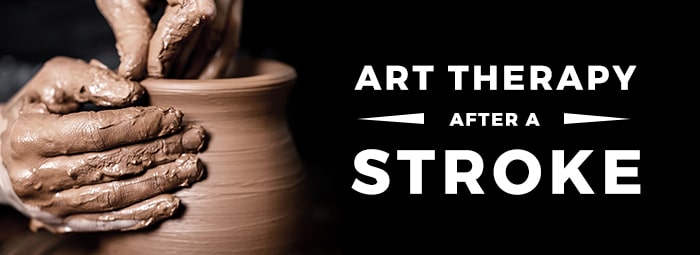Art Therapy Addresses Psychosocial Issues After a Stroke


Strokes are the leading cause of disability in the United States. A stroke occurs when oxygen and nutrients are unable to reach the brain, because of either a blood clot or a ruptured artery. When brain cells are starved of oxygen, they die, and the function those cells provide is impacted. The effect of a stroke depends on many variables, including the location of the obstruction or rupture and how much brain tissue is damaged. Without proper and immediate medical treatment, a stroke may cause long-term disabilities. Most post-stroke therapy focuses on recovering function. For example, physical therapy works to improve mobility and balance, occupational therapy is designed to increase independence with tasks of daily living, and speech therapy treats speech, language and swallowing problems. However, stroke patients may also experience psychosocial problems, such as depression or anxiety. Art therapy has proven to be an effective solution.
Psychosocial Issues and Stroke
Strokes can have a significant impact on the human body, and the emotional and practical struggle to adjust to those changes may influence a stroke survivor’s recovery. Functional deficits, such as poor mobility or speech impairments, may negatively affect a patient’s self-esteem and increase stress, frustration, and feelings of helplessness. Cognitive issues and memory loss may limit an individual’s ability to engage in social interactions safely and comfortably. As a result, experts say, one-third of people recovering from a stroke are likely to suffer from depression, one-fourth may experience significant anxiety, and about 20 percent will have insomnia. In addition to affecting quality of life in their own right, these issues can negatively impact the outcome of physical, occupational, and speech therapy, as well as the speed of recovery.
What Is Art Therapy?
Art therapy is based on the belief that self-expression and the human creative process have the ability to enhance healing. The therapy targets both hemispheres of the brain: the right hemisphere, which is responsible for spatial and visual information, such as recalling images and identifying differences between colors, and the left hemisphere, which is responsible for analyzing information, performing organizational tasks, and verbal communication. When the brain functions correctly, the two hemispheres integrate and work together. Art therapy encourages proper brain integration through various activities that may include coloring, sewing or knitting, creating murals, crafting “heart boxes” out of a shoebox, designing cards or postcards, making puppets, painting, sketching, drawing, sculpture, collage, and doodling.
How Does Art Therapy Work?
Art therapy is used to treat anxiety, depression, addiction, and other psychosocial issues that arise from the trauma and disability caused by a stroke. It is believed that when an individual focuses on the act of creating, other issues and problems disappear. For example, the physical act of pounding and throwing clay may help relieve stress, while painting or drawing may be soothing or calming. Art therapists believe that art can be used to physically communicate what cannot be said verbally. Through the act of creating, people may open a window into their emotions, thoughts, and problems, thereby regaining control of their lives and increasing self-esteem. It is also believed that art therapy stimulates the brain, activating neuroplasticity — the ability of the brain to repair or rewire itself to restore functions damaged by a stroke. For all these reasons, therapists have begun using art as a way to treat stroke-related physical, cognitive, and neurological issues.
Art projects are designed to stimulate the senses, cultivate a safe environment for self-exploration, and encourage self-expression, creativity and imagination. The benefits include:
-
- Engagement and connection. Patients are engaged in a leisure activity that promotes stroke recovery and offers opportunities for patients and families to connect.
- Recreation in a group setting. Individuals have the opportunity to participate in a group activity, one that is anticipated and enjoyed.
- Enhanced physical and occupational therapy. Stroke survivors who have trouble communicating and/or are easily disoriented and confused often respond well to art activities. In particular, stroke survivors who have lost the use of a limb, or important skills of daily living, may experience enhanced psychosocial benefits from art therapy.
- Convenience and creativity. Every stroke patient can participate in art therapy, regardless of skill or experience.
- A sense of accomplishment, and heightened self-esteem. Creating art is an achievement, whether it’s a painting, a sculpture, or a craft project. During the holiday season, patients particularly enjoy creating ornaments, holiday trees, and garlands that are hung in their homes or facilities.
Art Therapy Has Long-Term Benefits
Patients may continue to enjoy the benefits of art therapy at home. Crafting kits, adult coloring books, and other art projects will not only address psychosocial issues, they will also enhance functional recovery. Here at Saebo, we are committed to stroke support and recovery for all survivors and their families. Saebo offers a wide range of products that combine cutting-edge technology with evidence-based rehabilitation techniques. Our offerings and network of Saebo-trained therapists can help you or a loved one to obtain all the necessary tools to maximize stroke recovery.
All content provided on this blog is for informational purposes only and is not intended to be a substitute for professional medical advice, diagnosis, or treatment. Always seek the advice of your physician or other qualified health provider with any questions you may have regarding a medical condition. If you think you may have a medical emergency, call your doctor or 911 immediately. Reliance on any information provided by the Saebo website is solely at your own risk.
All content provided on this blog is for informational purposes only and is not intended to be a substitute for professional medical advice, diagnosis, or treatment. Always seek the advice of your physician or other qualified health providers with any questions you may have regarding a medical condition. If you think you may have a medical emergency, call your doctor or 911 immediately. Reliance on any information provided by the Saebo website is solely at your own risk.



